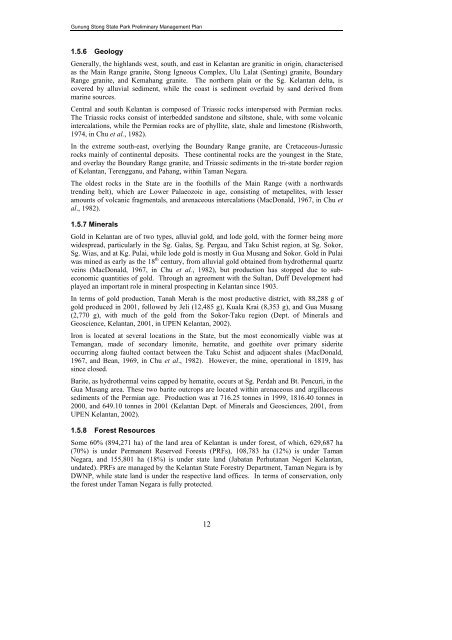FINAL VERSION FOR APPROVAL - Sdn Bhd - WWF Malaysia
FINAL VERSION FOR APPROVAL - Sdn Bhd - WWF Malaysia
FINAL VERSION FOR APPROVAL - Sdn Bhd - WWF Malaysia
You also want an ePaper? Increase the reach of your titles
YUMPU automatically turns print PDFs into web optimized ePapers that Google loves.
Gunung Stong State Park Preliminary Management Plan<br />
1.5.6 Geology<br />
Generally, the highlands west, south, and east in Kelantan are granitic in origin, characterised<br />
as the Main Range granite, Stong Igneous Complex, Ulu Lalat (Senting) granite, Boundary<br />
Range granite, and Kemahang granite. The northern plain or the Sg. Kelantan delta, is<br />
covered by alluvial sediment, while the coast is sediment overlaid by sand derived from<br />
marine sources.<br />
Central and south Kelantan is composed of Triassic rocks interspersed with Permian rocks.<br />
The Triassic rocks consist of interbedded sandstone and siltstone, shale, with some volcanic<br />
intercalations, while the Permian rocks are of phyllite, slate, shale and limestone (Rishworth,<br />
1974, in Chu et al., 1982).<br />
In the extreme south-east, overlying the Boundary Range granite, are Cretaceous-Jurassic<br />
rocks mainly of continental deposits. These continental rocks are the youngest in the State,<br />
and overlay the Boundary Range granite, and Triassic sediments in the tri-state border region<br />
of Kelantan, Terengganu, and Pahang, within Taman Negara.<br />
The oldest rocks in the State are in the foothills of the Main Range (with a northwards<br />
trending belt), which are Lower Palaeozoic in age, consisting of metapelites, with lesser<br />
amounts of volcanic fragmentals, and arenaceous intercalations (MacDonald, 1967, in Chu et<br />
al., 1982).<br />
1.5.7 Minerals<br />
Gold in Kelantan are of two types, alluvial gold, and lode gold, with the former being more<br />
widespread, particularly in the Sg. Galas, Sg. Pergau, and Taku Schist region, at Sg. Sokor,<br />
Sg. Wias, and at Kg. Pulai, while lode gold is mostly in Gua Musang and Sokor. Gold in Pulai<br />
was mined as early as the 18 th century, from alluvial gold obtained from hydrothermal quartz<br />
veins (MacDonald, 1967, in Chu et al., 1982), but production has stopped due to subeconomic<br />
quantities of gold. Through an agreement with the Sultan, Duff Development had<br />
played an important role in mineral prospecting in Kelantan since 1903.<br />
In terms of gold production, Tanah Merah is the most productive district, with 88,288 g of<br />
gold produced in 2001, followed by Jeli (12,485 g), Kuala Krai (8,353 g), and Gua Musang<br />
(2,770 g), with much of the gold from the Sokor-Taku region (Dept. of Minerals and<br />
Geoscience, Kelantan, 2001, in UPEN Kelantan, 2002).<br />
Iron is located at several locations in the State, but the most economically viable was at<br />
Temangan, made of secondary limonite, hematite, and goethite over primary siderite<br />
occurring along faulted contact between the Taku Schist and adjacent shales (MacDonald,<br />
1967, and Bean, 1969, in Chu et al., 1982). However, the mine, operational in 1819, has<br />
since closed.<br />
Barite, as hydrothermal veins capped by hematite, occurs at Sg. Perdah and Bt. Pencuri, in the<br />
Gua Musang area. These two barite outcrops are located within arenaceous and argillaceous<br />
sediments of the Permian age. Production was at 716.25 tonnes in 1999, 1816.40 tonnes in<br />
2000, and 649.10 tonnes in 2001 (Kelantan Dept. of Minerals and Geosciences, 2001, from<br />
UPEN Kelantan, 2002).<br />
1.5.8 Forest Resources<br />
Some 60% (894,271 ha) of the land area of Kelantan is under forest, of which, 629,687 ha<br />
(70%) is under Permanent Reserved Forests (PRFs), 108,783 ha (12%) is under Taman<br />
Negara, and 155,801 ha (18%) is under state land (Jabatan Perhutanan Negeri Kelantan,<br />
undated). PRFs are managed by the Kelantan State Forestry Department, Taman Negara is by<br />
DWNP, while state land is under the respective land offices. In terms of conservation, only<br />
the forest under Taman Negara is fully protected.<br />
12
















